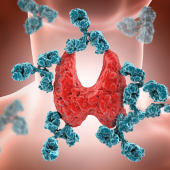Most people agree that midlife is that golden period between 45 and 65 years of age, marked by physical, cognitive and social changes as we grow older, including our sexuality. In a culture so conflicted about sex, it is no surprise that sexuality in middle age is seldom discussed, especially if it involves illness - or even end of life.
That is exactly why the team here at Nutramedica sat up and took notice when Dr Judith Boice approached us to produce a series on sexuality in midlife, including sex during and after chronic illness. Dr Boice is a naturopathic physician who has been in practice for 27 years. She is an international bestselling author and an award-winning educator.
Key Take-Aways
Sexuality In Mid-Life Is Seldom Talked About
Patients’ concerns over aspects of their sexuality - especially during chronic illness - are seldom discussed with primary care physicians. Having worked with patients with cancer and other chronic diseases, Dr Boice realized couples had a deep need to get these issues out in the open and confront challenges head on.
She decided to shine a light on the issue and open up the conversation with doctors and patients.
Understanding The Connection Between Sex And Love
Intimate relationships usually commence with an dizzying hormonal ride that drives sexual desire. This period can last up to two years.
After this initial period of infatuation, couples must have built a foundation of trust, common interests and an emotional connection for the relationship to grow and last.
Sexuality In Long-Term Relationships
Maintaining sexual desire in a long-term committed relationship takes intention and commitment. As couples age their core “chi”, vital life force, declines. This is a result of aging, hormonal changes and sometimes adrenal fatigue.
Chronic disease, like cardiovascular disease, diabetes, or cancer, can also suppress sexual desire and function. For example, genito-urinary syndrome affects up to 90% of post-menopausal women.
Blossoming Sexuality In Mid-Life
Mid-life can be a very sexy time. Especially for women. In many cases children have left the house, couples can discover a new intimacy.
Without distractions, mid-life allows couples to re-focus on their relationships and for the first time in many years, enjoy privacy in their home. Alternatively, both men and women may rediscover the joy of sex in a new relationship.
Hormonally, sex can improve after menopause because while testosterone levels stay relatively stable, estrogen and progesterone drop, resulting in some women enjoying increased libido.
For both men and women, this can be one of the most intimate and fulfilling times in their sexual lives as both discover that sexuality doesn’t always have to mean intercourse. Role playing and fantasy come to the fore and new vistas of pleasure open up.
Shifting Body Shapes With Aging
As we age, our body shape begins to shift as a result of hormonal changes. This can be disconcerting for both men and women. When the issue is illness or even chronic disease, it can be a sensitive issue.
Practitioners have a role in linking a healthy lifestyle, diet and exercise with continued sexual desire and function in mid-life.
Living With Chronic Illness
With the impact that chronic disease has on sexual desire and function, its important that couples learn how to discuss their sexuality in an honest and open manner.
If pain or energy is an issue, couples may need to schedule time for sex to optimize their desire and performance, making sex something to look forward to and something to plan around.
STD’s in Mid-life
The second most likely group to acquire STDs are those 55 years and older. That is stunning for most practitioners to learn and as a result, patients in mid-life are seldom tested for STD’s.
However, with increased sexuality in mid-life as a result of new relationships and a new found sense of freedom, STD’s are on the rise for middle aged men and women.
Talking to patients about using protection during sex is an important consideration for practitioners.
The Role of Practitioners
Practitioners can help patients by opening up a dialogue around some of the concerns that can limit sexual activities. Cardiovascular health, supporting and regulating blood sugar levels and helping address musculoskeletal pain are issues health professionals can address that support patients being able to enjoy fulfilling sexual lives in mid-life.
Key Quotes
“We can be sexual throughout our whole lives but for people who are struggling with chronic health issues, there is also no shame or no requirement to be sexually active as well. Sometimes I feel like there's this expectation that we're all supposed to be like 20-year-olds.” Dr Judith Boice
“As a culture, we should welcome the changes that both men and women go through and recognize that beauty that is still very much present in our bodies. They maybe changing bodies and they are still very much, beautiful bodies.” Dr Judith Boice
“I'd say foreplay ideally would start three or four days ahead. Start to send or leave little messages and text things and make more time for conversation. Sex starts ahead of time.” Dr Judith Boice
“Many women and men say that sex is the best it's ever been (in mid-life). It becomes more about meeting emotionally - as well as physically. But if there's no talking going on, there's probably no sex happening.” Dr Judith Boice
==
The opinions expressed in this Nutramedica program are those of the guests and contributors. They do not necessarily reflect the opinions of Nutritional Fundamentals For Health Inc.
This video is intended for licensed or registered health professionals and students of health professions only. These statements have not been evaluated by the Food and Drug Administration. Information contained in these programs are not intended to diagnose, treat, cure or prevent any disease.



